+ データを開く
データを開く
- 基本情報
基本情報
| 登録情報 | データベース: PDB / ID: 2k1d | ||||||
|---|---|---|---|---|---|---|---|
| タイトル | NMR Studies of a Pathogenic Mutant (D178N) of the Human Prion Protein | ||||||
 要素 要素 | Major prion protein | ||||||
 キーワード キーワード | UNKNOWN FUNCTION /  prion protein / M/V 129 polymorphism / D178N / disease mutation / FFI / GSS / prion protein / M/V 129 polymorphism / D178N / disease mutation / FFI / GSS /  Glycoprotein (糖タンパク質) / Glycoprotein (糖タンパク質) /  Golgi apparatus (ゴルジ体) / Golgi apparatus (ゴルジ体) /  GPI-anchor (グリコシルホスファチジルイノシトール) / GPI-anchor (グリコシルホスファチジルイノシトール) /  Lipoprotein (リポタンパク質) / Lipoprotein (リポタンパク質) /  Membrane (生体膜) Membrane (生体膜) | ||||||
| 機能・相同性 |  機能・相同性情報 機能・相同性情報: / negative regulation of amyloid precursor protein catabolic process /  lamin binding / regulation of glutamate receptor signaling pathway / regulation of calcium ion import across plasma membrane / aspartic-type endopeptidase inhibitor activity / lamin binding / regulation of glutamate receptor signaling pathway / regulation of calcium ion import across plasma membrane / aspartic-type endopeptidase inhibitor activity /  glycosaminoglycan binding / negative regulation of interleukin-17 production / ATP-dependent protein binding / regulation of potassium ion transmembrane transport ...: / negative regulation of amyloid precursor protein catabolic process / glycosaminoglycan binding / negative regulation of interleukin-17 production / ATP-dependent protein binding / regulation of potassium ion transmembrane transport ...: / negative regulation of amyloid precursor protein catabolic process /  lamin binding / regulation of glutamate receptor signaling pathway / regulation of calcium ion import across plasma membrane / aspartic-type endopeptidase inhibitor activity / lamin binding / regulation of glutamate receptor signaling pathway / regulation of calcium ion import across plasma membrane / aspartic-type endopeptidase inhibitor activity /  glycosaminoglycan binding / negative regulation of interleukin-17 production / ATP-dependent protein binding / regulation of potassium ion transmembrane transport / NCAM1 interactions / negative regulation of dendritic spine maintenance / type 5 metabotropic glutamate receptor binding / cupric ion binding / negative regulation of protein processing / negative regulation of calcineurin-NFAT signaling cascade / glycosaminoglycan binding / negative regulation of interleukin-17 production / ATP-dependent protein binding / regulation of potassium ion transmembrane transport / NCAM1 interactions / negative regulation of dendritic spine maintenance / type 5 metabotropic glutamate receptor binding / cupric ion binding / negative regulation of protein processing / negative regulation of calcineurin-NFAT signaling cascade /  dendritic spine maintenance / negative regulation of interleukin-2 production / negative regulation of T cell receptor signaling pathway / Insertion of tail-anchored proteins into the endoplasmic reticulum membrane / dendritic spine maintenance / negative regulation of interleukin-2 production / negative regulation of T cell receptor signaling pathway / Insertion of tail-anchored proteins into the endoplasmic reticulum membrane /  extrinsic component of membrane / cuprous ion binding / negative regulation of amyloid-beta formation / negative regulation of activated T cell proliferation / response to amyloid-beta / : / negative regulation of type II interferon production / intracellular copper ion homeostasis / positive regulation of protein targeting to membrane / negative regulation of long-term synaptic potentiation / positive regulation of protein tyrosine kinase activity / extrinsic component of membrane / cuprous ion binding / negative regulation of amyloid-beta formation / negative regulation of activated T cell proliferation / response to amyloid-beta / : / negative regulation of type II interferon production / intracellular copper ion homeostasis / positive regulation of protein targeting to membrane / negative regulation of long-term synaptic potentiation / positive regulation of protein tyrosine kinase activity /  long-term memory / response to cadmium ion / long-term memory / response to cadmium ion /  封入体 / regulation of peptidyl-tyrosine phosphorylation / cellular response to copper ion / neuron projection maintenance / molecular condensate scaffold activity / 封入体 / regulation of peptidyl-tyrosine phosphorylation / cellular response to copper ion / neuron projection maintenance / molecular condensate scaffold activity /  tubulin binding / protein sequestering activity / negative regulation of protein phosphorylation / molecular function activator activity / positive regulation of protein localization to plasma membrane / protein destabilization / protein homooligomerization / negative regulation of DNA-binding transcription factor activity / tubulin binding / protein sequestering activity / negative regulation of protein phosphorylation / molecular function activator activity / positive regulation of protein localization to plasma membrane / protein destabilization / protein homooligomerization / negative regulation of DNA-binding transcription factor activity /  terminal bouton / cellular response to amyloid-beta / positive regulation of neuron apoptotic process / positive regulation of peptidyl-tyrosine phosphorylation / cellular response to xenobiotic stimulus / terminal bouton / cellular response to amyloid-beta / positive regulation of neuron apoptotic process / positive regulation of peptidyl-tyrosine phosphorylation / cellular response to xenobiotic stimulus /  signaling receptor activity / signaling receptor activity /  amyloid-beta binding / protein-folding chaperone binding / postsynapse / amyloid-beta binding / protein-folding chaperone binding / postsynapse /  microtubule binding / microtubule binding /  核膜 / response to oxidative stress / 核膜 / response to oxidative stress /  protease binding / transmembrane transporter binding / protease binding / transmembrane transporter binding /  postsynaptic density / learning or memory / molecular adaptor activity / postsynaptic density / learning or memory / molecular adaptor activity /  regulation of cell cycle / regulation of cell cycle /  細胞周期 / 細胞周期 /  脂質ラフト / copper ion binding / external side of plasma membrane / intracellular membrane-bounded organelle / 脂質ラフト / copper ion binding / external side of plasma membrane / intracellular membrane-bounded organelle /  樹状突起 / protein-containing complex binding / negative regulation of apoptotic process / 樹状突起 / protein-containing complex binding / negative regulation of apoptotic process /  ゴルジ体 / ゴルジ体 /  細胞膜 / 細胞膜 /  小胞体 / extracellular exosome / identical protein binding / 小胞体 / extracellular exosome / identical protein binding /  細胞膜 / 細胞膜 /  細胞質基質 / 細胞質基質 /  細胞質 細胞質類似検索 - 分子機能 | ||||||
| 生物種 |   Homo sapiens (ヒト) Homo sapiens (ヒト) | ||||||
| 手法 |  溶液NMR / 溶液NMR /  simulated annealing, TORSION ANGLE DYNAMICS simulated annealing, TORSION ANGLE DYNAMICS | ||||||
 データ登録者 データ登録者 | Mills, J.L. / Surewicz, K. / Surewicz, W.K. / Sonnichsen, F.D. | ||||||
 引用 引用 |  ジャーナル: To be Published ジャーナル: To be Publishedタイトル: Residue 129 polymorphism and conformational dynamics of familial prion diseases associated with the human prion protein variant D178N 著者: Mills, J.L. / Surewicz, K. / Surewicz, W.K. / Sonnichsen, F.D. | ||||||
| 履歴 |
|
- 構造の表示
構造の表示
| 構造ビューア | 分子:  Molmil Molmil Jmol/JSmol Jmol/JSmol |
|---|
- ダウンロードとリンク
ダウンロードとリンク
- ダウンロード
ダウンロード
| PDBx/mmCIF形式 |  2k1d.cif.gz 2k1d.cif.gz | 675.9 KB | 表示 |  PDBx/mmCIF形式 PDBx/mmCIF形式 |
|---|---|---|---|---|
| PDB形式 |  pdb2k1d.ent.gz pdb2k1d.ent.gz | 568.4 KB | 表示 |  PDB形式 PDB形式 |
| PDBx/mmJSON形式 |  2k1d.json.gz 2k1d.json.gz | ツリー表示 |  PDBx/mmJSON形式 PDBx/mmJSON形式 | |
| その他 |  その他のダウンロード その他のダウンロード |
-検証レポート
| アーカイブディレクトリ |  https://data.pdbj.org/pub/pdb/validation_reports/k1/2k1d https://data.pdbj.org/pub/pdb/validation_reports/k1/2k1d ftp://data.pdbj.org/pub/pdb/validation_reports/k1/2k1d ftp://data.pdbj.org/pub/pdb/validation_reports/k1/2k1d | HTTPS FTP |
|---|
-関連構造データ
| 関連構造データ | |
|---|---|
| 類似構造データ | |
| その他のデータベース |
- リンク
リンク
- 集合体
集合体
| 登録構造単位 | 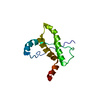
| |||||||||
|---|---|---|---|---|---|---|---|---|---|---|
| 1 |
| |||||||||
| NMR アンサンブル |
|
- 要素
要素
| #1: タンパク質 | 分子量: 16492.281 Da / 分子数: 1 / 断片: UNP residue 90-231 / 変異: D178N / 由来タイプ: 組換発現 / 由来: (組換発現)   Homo sapiens (ヒト) / 遺伝子: PRNP, PRIP, PRP / 発現宿主: Homo sapiens (ヒト) / 遺伝子: PRNP, PRIP, PRP / 発現宿主:   Escherichia coli (大腸菌) / 参照: UniProt: P04156 Escherichia coli (大腸菌) / 参照: UniProt: P04156 |
|---|
-実験情報
-実験
| 実験 | 手法:  溶液NMR 溶液NMR | ||||||||||||||||||||||||||||||||||||
|---|---|---|---|---|---|---|---|---|---|---|---|---|---|---|---|---|---|---|---|---|---|---|---|---|---|---|---|---|---|---|---|---|---|---|---|---|---|
| NMR実験 |
| ||||||||||||||||||||||||||||||||||||
| NMR実験の詳細 | Text: THE STRUCTURE WAS DETERMINED USING STANDARD TRIPLE RESONANCE EXPERIMENTS RECORDED WITH 13C, 15N LABELED PROTEIN |
- 試料調製
試料調製
| 詳細 | 内容: 350 uM [U-99% 13C; U-99% 15N] V129/D178N prion protein, 10 mM sodium acetate, 100 uM sodium azide, 90% H2O/10% D2O 溶媒系: 90% H2O/10% D2O | ||||||||||||||||
|---|---|---|---|---|---|---|---|---|---|---|---|---|---|---|---|---|---|
| 試料 |
| ||||||||||||||||
| 試料状態 | イオン強度: 20 / pH: 4.6 / 圧: AMBIENT / 温度: 299 K |
-NMR測定
| NMRスペクトロメーター | タイプ: BRUKER AVANCE600 / 製造業者: Bruker / モデル : AVANCE600 / 磁場強度: 600 MHz : AVANCE600 / 磁場強度: 600 MHz |
|---|
- 解析
解析
| NMR software |
| ||||||||||||||||
|---|---|---|---|---|---|---|---|---|---|---|---|---|---|---|---|---|---|
| 精密化 | 手法:  simulated annealing, TORSION ANGLE DYNAMICS / ソフトェア番号: 1 simulated annealing, TORSION ANGLE DYNAMICS / ソフトェア番号: 1 | ||||||||||||||||
| NMR constraints | NOE constraints total: 819 / NOE intraresidue total count: 306 / NOE long range total count: 123 / NOE medium range total count: 117 / NOE sequential total count: 273 | ||||||||||||||||
| 代表構造 | 選択基準: closest to the average | ||||||||||||||||
| NMRアンサンブル | コンフォーマー選択の基準: structures with the least restraint violations 計算したコンフォーマーの数: 100 / 登録したコンフォーマーの数: 20 |
 ムービー
ムービー コントローラー
コントローラー



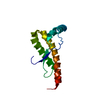
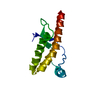




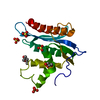

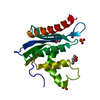
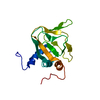

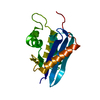
 PDBj
PDBj


